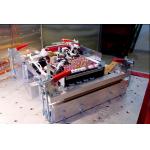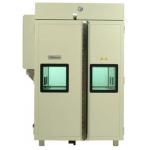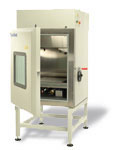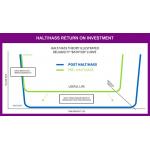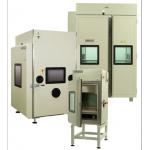Accelerated Testing
HALT and HASS accelerated testing equipment reduces product failures.
Latest News
September 1, 2006
By Dave Rizzo
Both HALT (highly accelerated life testing) and HASS (highly accelerated stress screening) are increasingly recognized as the fastest and most effective standards for design verification and testing (DVT) and production screenings. The impact of these testing methods is now reaching all the way up into the boardroom, where C-level executives have awaken to the fact that HALT and HASS can translate into highly accelerated income. Leaders across a broad range of industries are embracing accelerated testing as a strategic move that can increase competitiveness and improve market share.
Shortcut and Avoid the Problems of Slower Methods
HALT and HASS techniques can increase the speed of product development because they shortcut and avoid the problems of slower traditional testing methods, which tend to test to minimum specifications only. HALT and HASS can expose any weak links in a product quickly by testing well beyond minimum specs, which enables reliability problems to be discovered and fixed before they become expensive field issues. Because of this accelerated testing is deployed across a wide range of industries, especially with manufacturers of products containing a microprocessor, circuit card, or electromechanical assembly.
“You can use accelerated testing for testing components, subassemblies, or finished products, so we use it at all three levels,” says Brian Dahl, Environmental Test Engineer at Agilent Technologies.
|
|
| An item about to undergo accelerated testing. |
“HALT has become a culture here,” continues Dahl. “We started using it as soon as we select system components like disk drives, power supplies, and motherboards. We use the equipment from QualMark to test at every stage from prototyping to production to make sure the end product is robust and meets or exceeds our customer’s expectations. I chose the QualMark HALT chambers because the equipment really impressed me. In addition, their people are really great to work with: sales, field service, and management.”
“Accelerated testing always shortens product development cycles because it allows for earlier detection of reliability problems: weak components, timing relationships, things like that,” says Brian Flanagan, Hardware Qualification Manager for McDATA, a provider of enterprise storage networking products.
“We recently used the QualMark equipment to do hardware qualification testing for McDATA’s new 4Gb/s blade enhancement to the award-winning Intrepid 10,000 platform, a 256-port director that has 10Gb/s capabilities,” continues Flanagan. “Without HALT testing, this likely would have taken 6 to 9 months. Using the QualMark chambers, it only took us eight weeks.”
“HALT and HASS are better than traditional testing primarily due to the time compression that occurs during testing—by simultaneously incorporating multiple stresses, such as thermal and vibration, you can identify design and manufacturing deficiencies in a very short manner,” agrees Pat Kader, Quality Engineering Manager at Harris RF Communications.
Improving Reliability
Accelerated testing can prove effective at screening-out failures that may have gone undetected during traditional burn-in testing processes because it goes beyond normal testing and verifies the integrity of mechanical interconnects and component tolerance compatibility. A product that passes assures manufacturing-process quality and workmanship integrity, which increases out-of-box quality and field reliability and decreases field service and warranty costs.
“When I started this job, power supplies were the highest failing items in our division,” says Agilent’s Dahl, “but thanks to accelerated testing it’s almost a non-issue now. In one particular case, HALT helped us go back to a vendor to show them where their product failed. The vendor redesigned the power supply, which subsequently passed the accelerated stress screenings. We awarded the business to that supplier. We have since fielded over a thousand of those power supplies. Guess how many have failed? Zero!”
In the case of mission-critical applications, accelerated testing becomes essential because having extremely high product reliability represents the only way of doing business.
|
|
| QualMark’s HASS Chamber Typhoon-4.0 |
> > The HASS Chamber Typhoon-4.0 is the largest chamber in the QualMark line. Its 48- x 48-inch vibration table can of support hundreds of pounds of products and fixturing.
“In our industry, ‘product maturity’ means delivering products with a very high operational reliability, from the very first delivery,” explains Daniel Goulet, Test Strategy and Product Maturity Manager in the Industrial Operation Division of Thales-Avionics, a division of Thales. “Our products end up in planes manufactured by Airbus, Boeing, and others, so there is no room for failure.”
“However, to get product maturity at entry into service was initially taking months, or sometimes years, due to the time required to discover any issues,” continues Goulet. “But our customers, like Airbus, do not want to wait ... So that is why we decided to introduce product maturity methodologies that included HALT to discover and fix weaknesses, and HASS to catch infant failures.
“We now use QualMark equipment to apply a very high level of constraints on our products … to uncover issues very quickly. I have some examples of product testing, where, after 2 to 3 hours of running HALT and HASS, we discovered issues that normally required 2 to 3 weeks or months of testing with traditional equipment and procedures.”
Reducing Warranty Claims
Accelerated testing can significantly reduce or even eliminate recall and repair expenses. It can even help solve problems in products released before a manufacturer adopted HALT and HASS techniques.
“When I first came on board we had a brand new vehicle-based product and these units were failing in the field at a rate that was unacceptable given Xantrex’s high quality requirements,” recalls Harry McLean, Manager, Reliability Engineering for Xantrex Technology, a developer of advanced power electronics products and systems.
|
|
| QualMark’s HALT Chamber Typhoon-2.0 |
< < QualMark’s HALT Chamber Typhoon-2.0 offers a 24- x 24-inch vibration table.
“Attempts were made to duplicate the field failure using traditional vibration and thermal testing, but it couldn’t be done,” continues McLean. “So I employed a HALT using a QualMark chamber. I chose them because their tables provide energy in six axes—X, Y ,Z, pitch, yaw, and roll—so you have the orthogonal vectors plus the rotational vectors. Within 30 minutes, I was able to produce the same failure mode the products were experiencing in the field. So we made design improvements to the product and, as a result, the last time I checked on this product, we have had no failures in the field.”
Similar results on a previously released product have achieved by others.
“On one particular product … at another company I once worked for—not Harris—we were able to reduce field return rates from close to 30% down to less than 1% in one year by following the HALT and HASS process,” notes Kader.
Saving Hard Dollars
While conducting accelerated testing falls squarely within the domain of the engineering, the benefits ultimately appear in the CFO’s the books.
“Any time you can catch a potential reliability issue early on in a production qualification cycle, ]it’s] got huge connotations in terms of cost savings or cost avoidance, if it prevents finding that … failure over time in the field,” observes McDATA’s Flanagan.
|
|
| Courtesy of QualMark. |
“You do save money because if you get a failure in the field 2 to 3 months or one year after the product is released, then it is much more difficult and costly to fix it, than when you are at the design phase,” adds Goulet of Thales-Avionics.
“I once performed a back-of-the-envelope calculation that looked at the price of continuing accelerated testing with all the consumables and the investment in the chambers, versus stopping the program,” recounts Kader of his experience at a company he worked for before Harris. “I was able to convince my manager in less than 10 minutes to invest in additional HALT and HASS chambers during that meeting because the cost-savings was that considerable.”
Accelerating the Pace of Electronics Manufacturing
Bringing products to market faster while improving reliability provides manufacturers with a competitive edge over those companies favoring slower testing procedures.
“We already have about 22 pieces of QualMark equipment at 10 different sites, but I just ordered two more chambers for our in-flight-entertainment application,” says Goulet. “Qualification testing and DVT goes better and faster, and without any surprises.”
“We’re successful because with the HALT process, you can quickly find almost any issue, understand what causes it, take corrective action, and then verify it,” adds Xantrex’s McLean. “A recent success story demonstrating this is one of our newest products that converts solar energy to AC power. Xantrex has shipped literally thousands of units and we are in the sub-tenth of one percent in failure rate on that product. That great success rate is due in part to the fact that this product had been subjected to HALT throughout its design phase.”
Dave Rizzo is a technical writer based in Fullerton, CA. Send your comments about this article through e-mail by clicking here. Please reference “HALT and HASS, September 2006” in your message.
Typhoons from QualMark
QualMark’s line of HALT and HASS Typhoon Chambers incorporate liquid nitrogen cooling into a high ramp rate thermal system, and provide an integral six degree of freedom repetitive shock vibration system. Vibration table sizes range from 18 x 18 inches to 48 x 48 inches. Each system uses a complementary PC-based control system for manual control for HALT type testing and HASS test profile set up. A PLC enables on-the-spot control of the thermal and vibration subsystems.
|
|
| QualMark HALT and HASS chambers. |
QualMark has installed more than 700 of its testing systems in major corporations in 30 countries. The company recently acquired Ling Electronics, a manufacturer of electrodynamic shakers and amplifiers, ranging from 100 force pounds to 40,000 force pounds. QualMark also offers counseling and testing services. For more information on QualMark, click here. Click here for more on Ling Electronics. —DR
Companies Mentioned
Agilent Technologies, Inc.
Palo Alto, CA
Harris Corp. RF Communications Division
Rochester, NY
Ling Electronics
West Haven, CT
McDATA Corp.
Broomfield, CO
QualMark Corp.
Denver, CO
Thales-Avionics
Neuilly-sur-Seine, France
Xantrex Technology, Inc.
Burnaby, BC, Canada
Subscribe to our FREE magazine, FREE email newsletters or both!
Latest News
About the Author
DE’s editors contribute news and new product announcements to Digital Engineering.
Press releases may be sent to them via [email protected].







